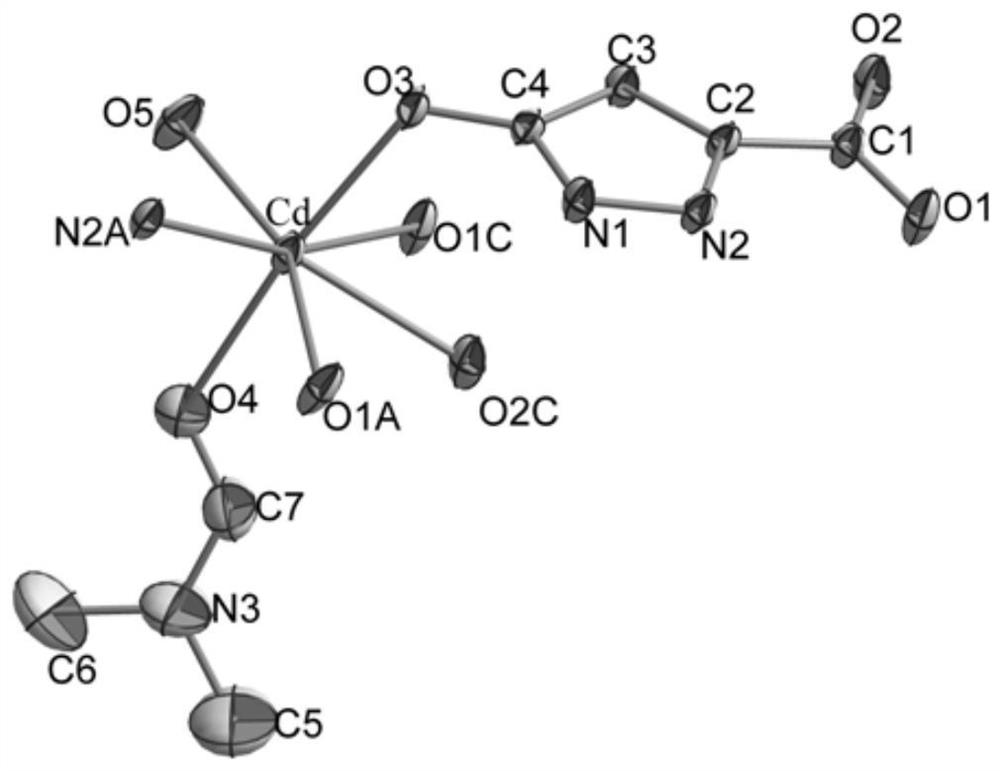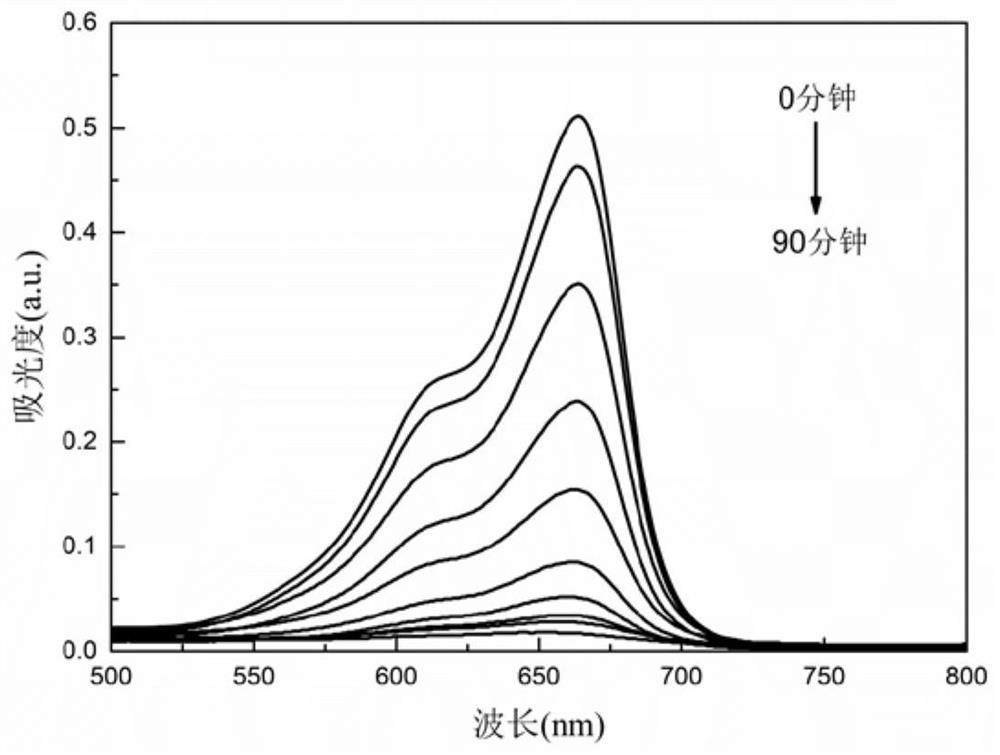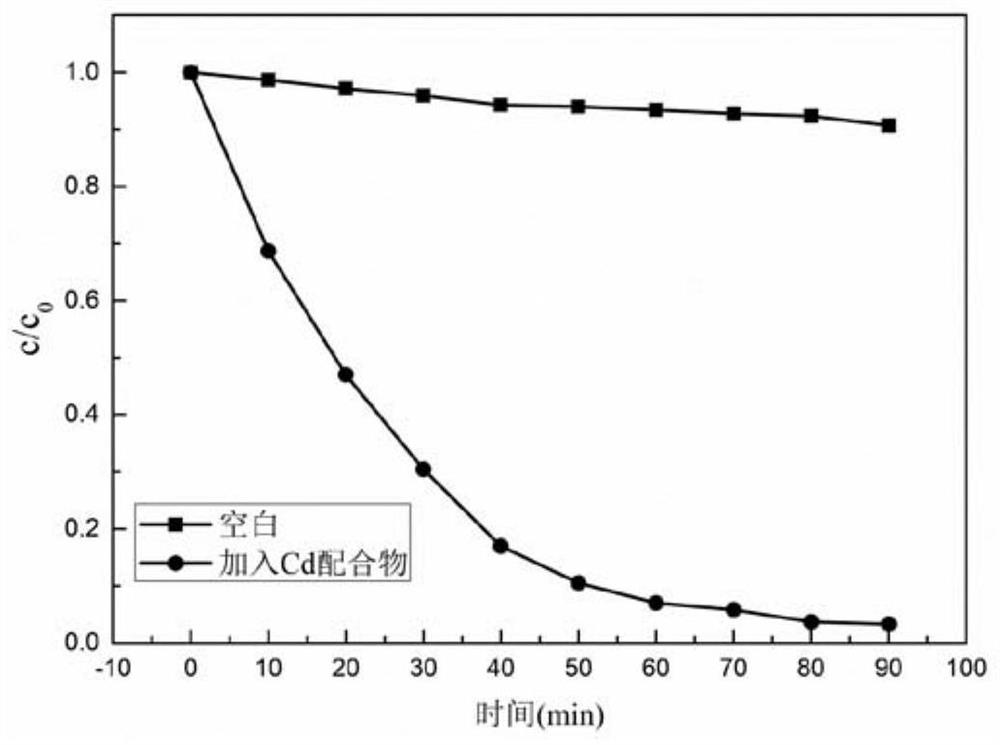Cadmium Hydroxypyrazolecarboxylate Coordination Polymer for Catalytic Degradation of Organic Dyes by Visible Light and Its Preparation and Application
A technology of cadmium coordination polymer and hydroxypyrazole carboxylic acid, applied in the field of photocatalytic materials, can solve problems such as secondary pollution of heavy metal ions, and achieve the effects of avoiding secondary pollution, convenient operation and high preparation efficiency
- Summary
- Abstract
- Description
- Claims
- Application Information
AI Technical Summary
Problems solved by technology
Method used
Image
Examples
Embodiment 1
[0024] Example 1: Preparation of cadmium hydroxypyrazolecarboxylate coordination polymer for visible light catalytic degradation of organic dyes
[0025] Weigh 5-hydroxypyrazole-3-carboxylic acid (0.05mmol, 0.0064g) and dissolve it in a mixture of 1.6mL DMF and 2mL distilled water to prepare a ligand solution. Weigh cadmium nitrate (0.1mmol, 0.0308g) to dissolve it. Add the cadmium nitrate solution to the ligand solution in 1 mL of distilled water and mix to obtain a transparent and colorless solution, react in a 90°C oven for 2 days, and cool to room temperature to obtain pale yellow bulk crystals, yield: 54.7%. The product was characterized by infrared, and the specific results were: IR (KBr, cm -1 ): 3252(m), 2360(w), 1665(s), 1580(s), 1446(s), 1359(m), 1263(w), 1149(m), 1014(m), 846(w) ), 752(m), 648(m), 570(w).
Embodiment 2
[0026] Example 2: Preparation of cadmium hydroxypyrazolecarboxylate coordination polymer for visible light catalytic degradation of organic dyes
[0027] Weigh 5-hydroxypyrazole-3-carboxylic acid (0.05mmol, 0.0064g) and dissolve it in a mixture of 1mL DMF and 2mL distilled water to prepare a ligand solution, weigh cadmium nitrate (0.1mmol, 0.0308g) and dissolve it in Add the cadmium nitrate solution to the ligand solution in 1 mL of distilled water and mix well to obtain a transparent and colorless solution, react in a 90°C oven for 1 day, and cool to room temperature to obtain pale yellow bulk crystals, yield: 51.4%. The product was characterized by infrared, and the specific results were: IR (KBr, cm -1 ): 3252(m), 2358(w), 1659(s), 1581(s), 1444(s), 1363(m), 1263(w), 1147(m), 1013(m), 848(w) ), 750(m), 649(m), 571(w).
[0028] Infrared test results show that the product of this example is the same as the product of Example 1.
Embodiment 3
[0029] Example 3: Preparation of cadmium hydroxypyrazolecarboxylate coordination polymer for visible light catalytic degradation of organic dyes
[0030] Weigh 5-hydroxypyrazole-3-carboxylic acid (0.05mmol, 0.0064g) and dissolve it in a mixture of 1.5mL DMF and 2mL distilled water to prepare a ligand solution. Weigh cadmium nitrate (0.08mmol, 0.0246g) to dissolve Add the cadmium nitrate solution to the ligand solution in 1 mL of distilled water and mix to obtain a colorless and transparent solution, react in a 100 ℃ oven for 1 day, and cool to room temperature to obtain pale yellow bulk crystals, yield: 53.2%. The product was characterized by infrared, and the specific results were: IR (KBr, cm -1 ): 3250(m), 2361(w), 1667(s), 1580(s), 1442(s), 1360(m), 1259(w), 1148(m), 1015(m), 846(w) ), 753(m), 645(m), 573(w).
[0031] Infrared test results show that the product of this example is the same as the product of Example 1.
[0032] The relevant crystallographic data of the Cd...
PUM
| Property | Measurement | Unit |
|---|---|---|
| catalytic efficiency | aaaaa | aaaaa |
Abstract
Description
Claims
Application Information
 Login to View More
Login to View More - R&D
- Intellectual Property
- Life Sciences
- Materials
- Tech Scout
- Unparalleled Data Quality
- Higher Quality Content
- 60% Fewer Hallucinations
Browse by: Latest US Patents, China's latest patents, Technical Efficacy Thesaurus, Application Domain, Technology Topic, Popular Technical Reports.
© 2025 PatSnap. All rights reserved.Legal|Privacy policy|Modern Slavery Act Transparency Statement|Sitemap|About US| Contact US: help@patsnap.com



